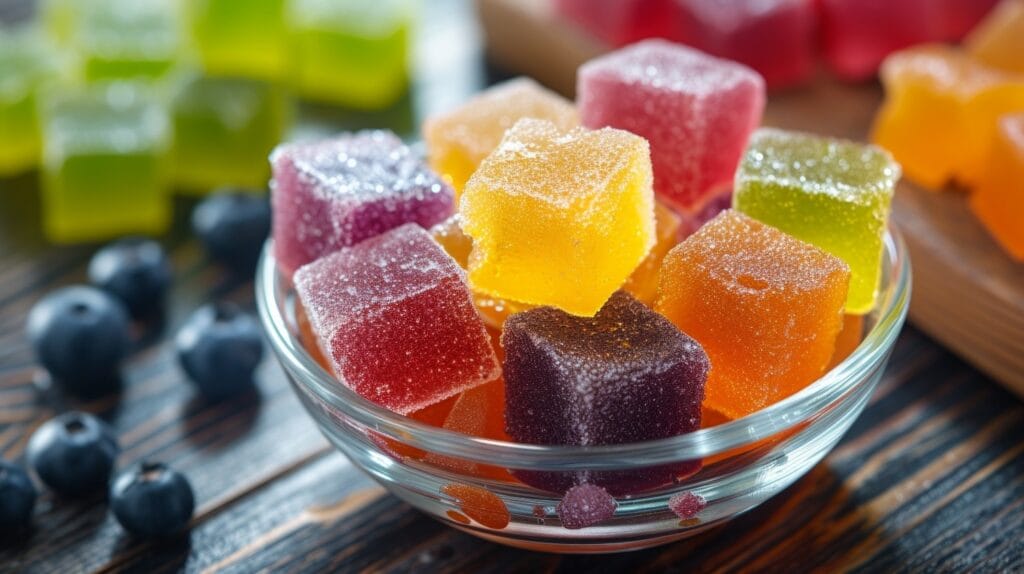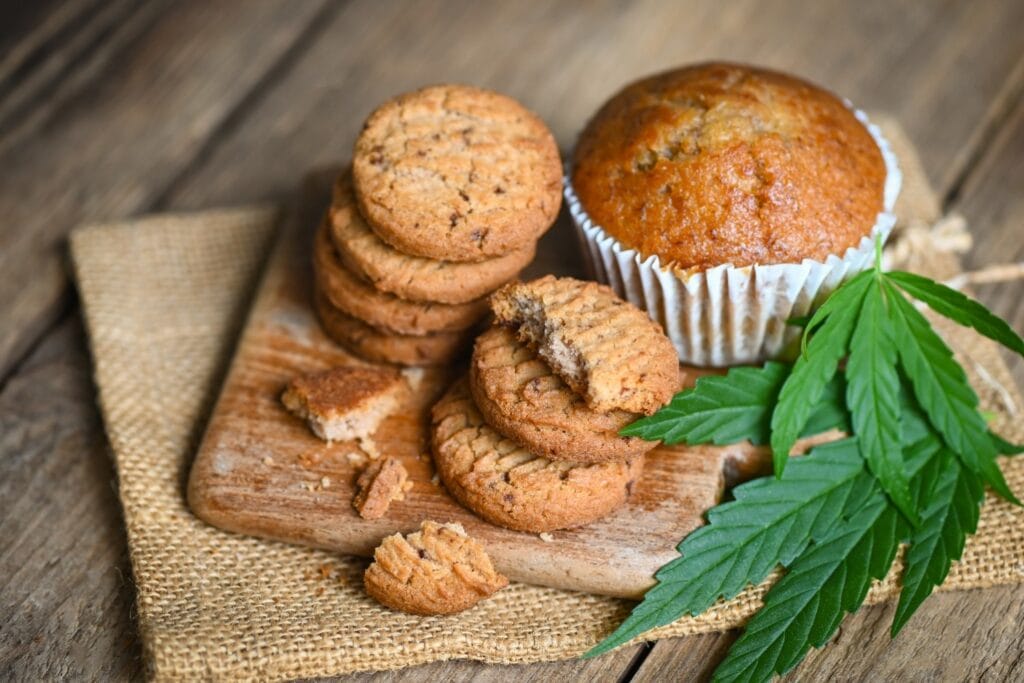Cannabis edibles are popular for their delicious taste, potent effects, and longer-lasting highs. The only issue is that most businesses currently offer edibles with limited dosages. To address this, cannabis advocates are pushing for a change in regulations. They are urging the federal government to update the Cannabis Act to raise the maximum allowable THC content in edibles from the current limit of 10 milligrams to 100 milligrams per package.
Find out why and how this affects you when buying edibles Canada.
Table of Contents
- What Are Edibles?
- Background on Tetrahydrocannabinol Edible Limits
- Reasons Why Advocates Want To Increase The Limit
- Industry and Market Impact
- Potential Medical Benefits of Higher Tetrahydrocannabinol Edible Limits
- Potent THC Edibles You Can Find in an Online Shop
- 10mg, 100mg, and 1000mg Edibles Canada at GrassLife
- Frequently Asked Questions

What Are Edibles?
Edible cannabis products, also known as medibles and eddies, are consumable items infused with cannabinoids. Cannabinoids are natural compounds found in weed that can impact both the mind and body when ingested.
THC (tetrahydrocannabinol) is a cannabinoid that induces euphoria and intoxication, referred to as feeling “high.” In contrast, CBD (cannabidiol) does not produce a high but may offer therapeutic benefits.
These can come in various forms, and despite sometimes resembling ordinary food, they do not add nutritional value. They offer a different way to consume weed compared to smoking or vaping.
Background on Tetrahydrocannabinol Edible Limits
The regulations on limits for weed edibles and extracts primarily protect consumer safety and ensure consistent product standards. For weed-containing foods, the limit is 10 mg per discrete unit, such as a single piece of candy or a brownie.
This cap applies to individual servings and the immediate container holding multiple servings. This limitation helps to prevent overconsumption and accidental ingestion, particularly by children.
The regulating bodies stated that this type of product must contain the following:
- More than 5 mg THC and CBD: The content must be less than 85% or more than 115% of that quantity.
- Between 2 mg and 5 mg THC and CBD: The actual content must be less than 80% or more than 120% of that quantity.
- Less than 2 mg THC and CBD: The content must be less than 75% or more than 125% of the labelled amount.
Reasons Why Advocates Want To Increase The Limit
Canadian advocates call for Health Canada to increase the maximum amount of tetrahydrocannabinol permitted in edible products from the current limit of 10 milligrams to 100 milligrams. They cited the need to align with cannabis promotion and meet evolving producers and consumer demands.
Competitive Disadvantage
Advocates argue that the current limit places licensed retailers at a significant disadvantage.
Jennawae Cavion, executive director of NORML Canada, notes that the low potency drives consumers to other markets where higher doses are available. She believes increasing the tetrahydrocannabinol limit would allow retailers to better compete with other sources. This adjustment could address market fairness concerns highlighted by the Competition Bureau.
Consumer Demand and Convenience
The authorized market does not meet substantial consumer demand for higher-dose oral selections. Liberal MP Patrick Weiler supports increasing the dosage, as many consumers seek this content than what is available.
Sam Gerges, owner of a cannabis company, points out that the low potency fails to meet the needs of consumers who seek or require stronger doses. It’s like selling non-alcoholic vodka and saying it’s real alcohol.
Raising the amount can better satisfy this demand and reduce consumer reliance on the illicit market. Higher potency would simplify consumption by reducing the need to buy multiple low-dose packages to achieve the desired effect.
Reduction of Waste
Cavion points out that higher cannabinoid strength would reduce the amount of packaging required. Consumers would need to buy fewer packages to reach their desired dosage.
This change would minimize environmental impact and make consumption more efficient by reducing excess cannabis packaging.
Alignment with International Practices
Another argument for raising the allowable content is aligning Canadian practices with those of other countries. Weiler notes that many U.S. states with authorized weed have adopted higher dosages, which could serve as a model for Canada. This alignment would help provide a consistent consumer experience and simplify the market by reflecting practices from established markets.
Industry and Market Impact
A key argument for raising the limit on edible weed is to balance the playing field between retailers and other types of sellers. The limitation can drive consumers toward other markets with readily available higher-potency options. Increasing the dosage could attract customers to retailers and boost their sales.
The bureau should not only focus on the licensing process or reducing compliance costs but also foster innovation by learning how to compete with other markets using their marketing strategies.
Economic and Operational Considerations
Raising the limit could economically address packaging and waste issues. Current regulations require multiple packages to achieve the desired dosage, which leads to excess packaging and environmental impact.
Reducing packaging can also positively impact business costs and customer expenses. Businesses can save money using less packaging because they only need to produce one high-dose package instead of multiple smaller ones to meet customer demand. Packaging contributes to overall operational costs, which may burden the customers.
Public Health and Regulatory Concerns
Some believe that raising the amount might harm public safety. Michael DeVillaer from McMaster University raises concerns that increasing the amount might be minimally intrusive as it compromises public health protections. He stated that researchers need to investigate whether customers genuinely demand high tetrahydrocannabinol food products.
Cavion views the issue as being as much about managing public attitudes as it is about public health. She argued that the government must avoid restricting the creativity of licensed producers. She added, “This isn’t an institutional product—it’s recreational and for enjoyment.”
Potential Medical Benefits of Higher Tetrahydrocannabinol Edible Limits
Most business owners want to increase the THC content due to high demand, while others aim to reduce waste from packaging. It’s also important to know that higher doses can offer significant medical benefits to many consumers.
- Pain management. Tetrahydrocannabinol interacts with CB1 receptors in the brain and spinal cord, which affects the perception of pain. Influences opioid receptors in these areas, which are involved in pain response.
- Muscle spasm control. Binds with cannabinoid receptors in the human endocannabinoid system, which reduces inflammatory proteins. This decrease in inflammatory proteins helps to suppress the spasm response.
- Appetite stimulation. Decreases Peptide YY (PYY) levels while increasing ghrelin levels and appetite. Activates the mTOR (mammalian target of rapamycin) pathway, which further raises ghrelin levels and increases appetite.
- Sleep problems. A 2022 study found that 71% of patients experienced improved sleep, and 39% could reduce or stop using prescription medications.

Potent THC Edibles You Can Find in an Online Shop
Struggling to find high-THC products at your local dispensary? Many websites offer a wide selection of potent gummies and chocolates. These products are lab-tested and come from reputable brands that adhere to strict protocols to ensure they are safe, even with higher levels of psychoactive compounds.
| Gummies | THC Content | Amount Per Piece | Pieces | Price |
| OneStop – Sour Cherry Lime Gummies | 500mg | 50mg | 10 | $17 |
| Potluck – Infused Chocolate – Cookies & Cream | 300mg | 25mg | 12 | $26 |
| High Dose – Cannabis Infused Gummies – Blackberry | 1000mg/1500mg | 1000mg/1500mg | 1 | $40-$56 |
| Doobie Snacks – Sour Wild Strawberry Gummies | 500mg | 50mg | 10 | $44 |
10mg, 100mg, and 1000mg Edibles Canada at GrassLife
GrassLife offers a user-friendly platform for purchasing edible products with varying tetrahydrocannabinol levels. By providing a range of options and focusing on quality, we cater to new and experienced consumers. Our commitment to safe, reliable products aligns with the growing demand for higher potency.
Frequently Asked Questions
Is ingesting marijuana more intense than inhaling?
For some individuals, the effects of edible weed can be more potent than inhaling an equivalent dose of dried weed. Edibles offer heightened intensity because the liver converts the active compound into a powerful form, 11-hydroxy-tetrahydrocannabinol.
Beginners should start with those containing no more than 2.5 mg and ideally use them with experienced friends or family.
Who benefits from increased tetrahydrocannabinol products?
Users with higher tolerances and patients needing stronger effects can benefit from potent oral marijuana products. Long-term cannabis users may need higher concentrations to experience the desired effects, while patients suffering from pain may require more powerful products for faster and longer-lasting symptom relief.
How does it feel to consume potent marijuana edibles?
It affects everyone differently. While some people may be highly sensitive to its effects, others might notice them less. It’s also possible to experience various stages of being high. For instance, feelings of euphoria peak after the THC concentration in the blood has reached its highest level. Some users say it produces more pronounced physical effects, sometimes leading to a “couch-lock” sensation.
Related Articles:



